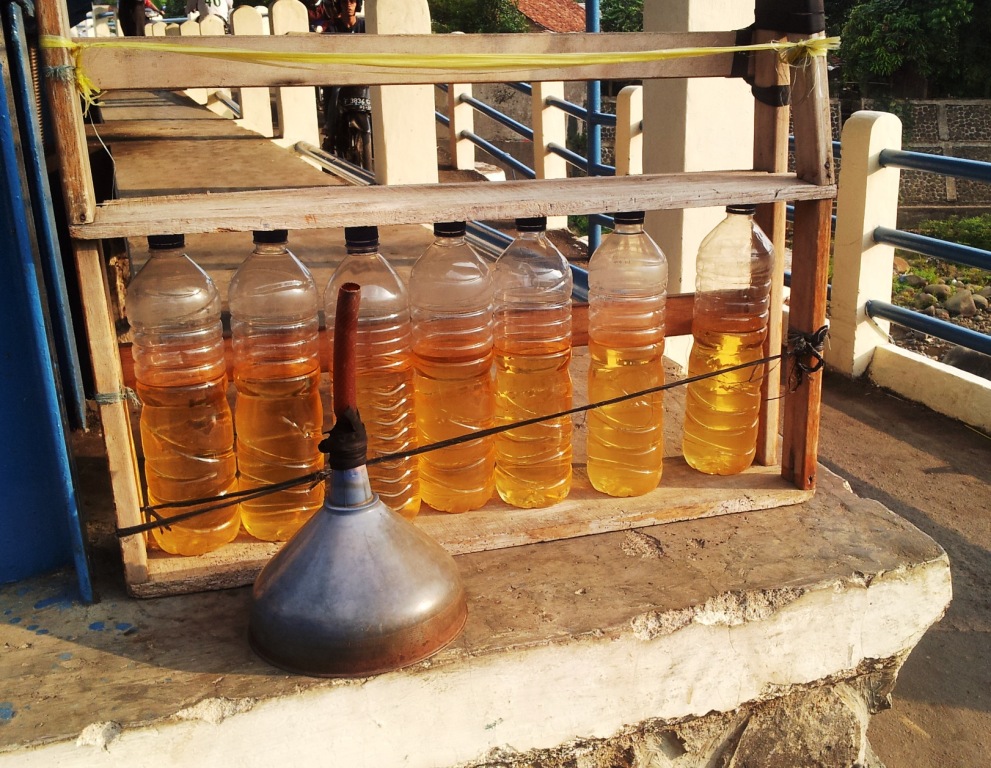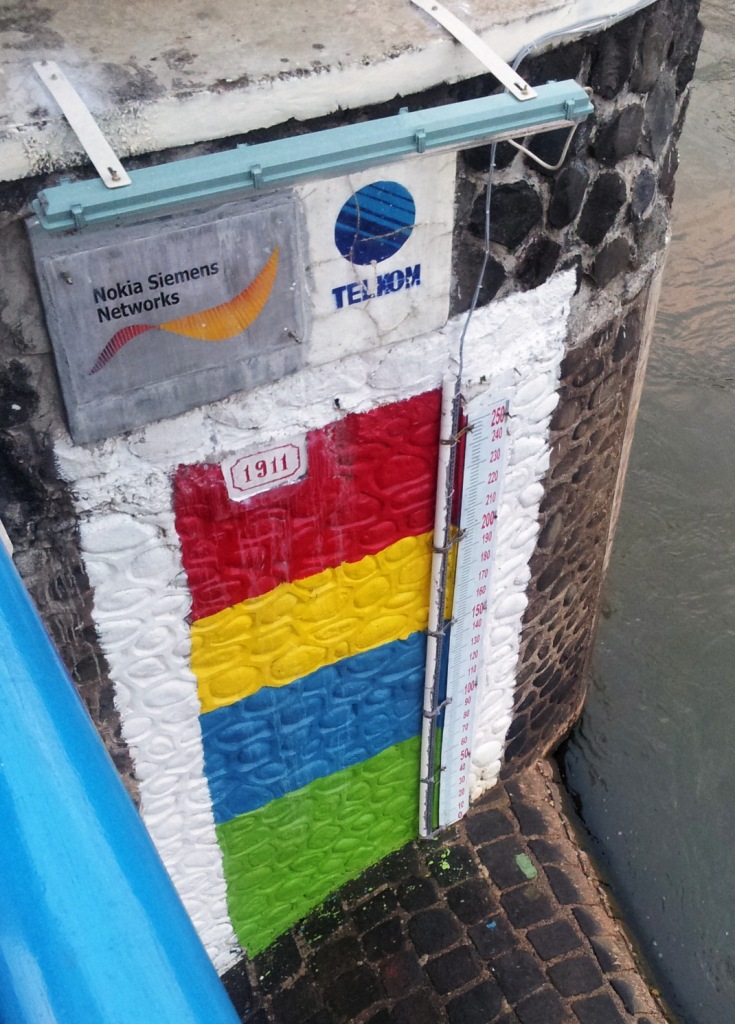Along the road to Katulampa dam, the canal was frothing from the splashing of swimming children. A small peanut of a girl ran full-throttle along-side our van while young boys dove into the water. When we arrived at the dam, fresh laundry was hanging on the wire fence around the raingage.
 |
| The irrigation canal at Katulampa. Raingage on the right. |
 |
| Boys playing on the gates to the natural channel. |
This place is just south of Bogor, about 50 km south of Jakarta. Whatever happens on this spot on the Ciliwung River happens in Jakarta about half a day later and so it is the most important site for Flood Early Warning in the city.
Katulampa Dam itself, built in 1911, is small and does not hold much water. Mostly it splits the Ciliwung River in two; the canal irrigates fields and there is a natural channel for use in times of high flow. The dam has a series of gates that can be raised or lowered to control the flow. It serves as a bridge from one side of the community to the other, wide enough for foot traffic and motorbikes. You can also buy gas there, hand-poured with a funnel from plastic water bottles.
Katulampa Dam itself, built in 1911, is small and does not hold much water. Mostly it splits the Ciliwung River in two; the canal irrigates fields and there is a natural channel for use in times of high flow. The dam has a series of gates that can be raised or lowered to control the flow. It serves as a bridge from one side of the community to the other, wide enough for foot traffic and motorbikes. You can also buy gas there, hand-poured with a funnel from plastic water bottles.
 |
| The Katulampa gas station |
Andi Sudirman (“Mr Andi”) is the station’s full-time operator and lives with his family two doors down from the dam (his morning commute is 50 feet long). His title ("Penjaga") translates into Guard or Keeper. He operates the gate but also maintains a nearby streamgage, the raingages, and other monitoring equipment. Several cameras transmit images of the water level. His workspace is neat and tidy. The office is mostly empty except for a backup power setup, emergency lights, cb radios, red sirens, log books, a video screen on the wall, cushions for sleeping on the floor, a couch, ashtray and so on. Everything around the site looks like it just got a fresh coat of paint.
 |
| Mr Andi's desk |
Mr Andi has a certain sense of style we had not seen often in Indonesia. The usual dress code for men is a white collared business shirt and slacks. He is trim and athletic. His sleek metal-framed glasses reminded me of those worn by Australian politicians… but his electric blue jersey and silver watch gave him a bit of hip-hop coolness. Add a diamond earring and a microphone and I think he could have the look of an Indonesian R and B singer.
 |
| Mr Andi, the Ciliwung Gate observer |
Mr Andi’s station has a set of flood levels (stages) that trigger events downstream. When the water at the gate reaches 80 cm (2.5 feet) deep, Mr Andi makes a call to downstream water managers and local government and he keeps them up to date on if the river is rising or falling. Above 150 cm (5 feet), eyebrows really start rising and preparations go into the more urgent "yellow zone" stage. Above 200 cm (6.5 feet) is the “red zone” where downstream evacuations are necessary.
 |
| Stages 1-4 marked on the side of the gate |
 |
| This is monitored by camera |
 |
| ...and is transmitted to the office and downstream. |
We had heard earlier in the day about the recent major floods in 2007 and asked about them. Funny enough, right behind us there’s a poster on the wall showing a time series chart of river levels during February 2007. This site went from 40 cm (1.3 feet) up to 250 cm (8.2 feet) in about 6 hours. This was because bucket-loads of rain had fallen upstream.
 |
| The poster of the 2007 flood. Time runs from left to right. The bottom line is the flood level at this site and the top line is the flood level downstream in Jakarta. |
The bottom half of the poster had a series of repeat photos of various spots on the river at different flow rates, from placid calm to babbling brook and through to roiling pandemonium. |
| About how things looked the day we were there (source) |
 |
| Progressively heavier runoff (source) |
 |
| Even heavier still (source) |
Reaching deep into my arsenal of penetrating questions, I asked “So… um… what was that like?” Our translator (Heru Yoko from the Research and Development Center of Water Resources) explained that the Standard Operating Procedure was to open the floodgates as far as they could go. The irrigation canal was also closed. Houses washed away and there were mud slides.
Consider this, though; in the 6 hours it took to go from business as usual to “Lord Almighty!” at the dam, the river was still flat in Jakarta. It’s the travel time between the sites that allows them to make a good forecast of what’s going to happen downstream. In military terms, 2007 must have been like a tiny outpost sending a wire to Berlin that a massive Allied invasion force had just landed at Normandy.
When I asked about if Mr Andi was worried about raising a false alarm, it must have translated as if he was worried about an error in the reading or if it was a data spike. No way, he just needed to walk from his office to see the gage. His office (and house for that matter) is right downstream of the dam, between the canal and the channel. The river was thundering by 3 meters (10 feet) from his window. Invasion-wise, we’re not talking the “possible sighting” of a submarine periscope… we’re talking bombers, battleships, marines on the beach, horizon to horizon, the air rumbling.
I pressed but “as a human, what was his experience?” What was he thinking? Was he excited? Afraid? Mr Andi’s response was an animated two minutes in Indonesian that translated roughly into “Really afraid. This whole thing was built 100 years ago. He gets worried for his safety when the river gets above 1 meter. In 2007, it didn’t have time to get to 1 meter, it just soared on up to 2 meters”.
He wouldn’t consider abandoning his post though. This is basically his job, his responsibility, to sit through months, years of tedium so that he could be here to operate the weir during those 6 hours when everything goes crazy.
(part 2 to follow)
This is all really fascinating. What a wonderfully rich and exciting life you lead!
ReplyDeleteSydney, I think I'm just lucky... and having good guides really helps!
ReplyDelete